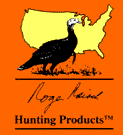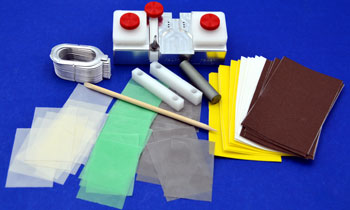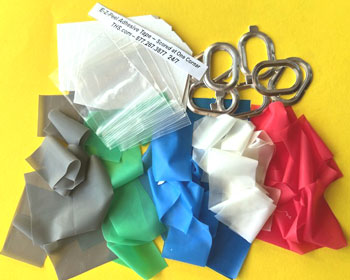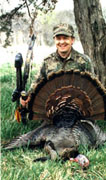Turkey Guns
Copyright © 1998 - 2021 Roger
W. Raisch * Nadine Adele, all rights reserved
|

CUSTOM Shotgun
Chokes
|
WorldChampion
Comp-N-Choke
as low as $
47.99
for
Remington, Benelli, Beretta, Mossberg,
Winchoke
|
What most authors
fail to tell you about turkey guns is that the proper fit of your gun can be as important
as your choice of gauge and shot size. A poorly fitted
gun can cost you a turkey even if you do everything else right.
Proper gun fit is an accepted cause for poor wing shooting, but in many situations it is
equally important to the turkey hunter.
|
Because your target
is small, you must aim, not just point your gun at the turkey.
A gun that doesn't automatically align your eye along the top of the barrel each time you
bring it to your shoulder may cause you to miss a turkey that is in easy range.
Turkeys often circle and approach from the rear or come in at unexpected angles.
Since you'll be shooting mostly from unaccustomed sitting positions, and often twisted
around to one side or the other, proper gun alignment is often difficult even with a
custom-fit gun. In the excitement of the moment it is easy to lose concentration and
look over the top of the barrel at the turkey rather than holding your face down on the
gun. A properly fit gun will help you aim correctly.
|
If your gun has just
a single front bead, have a second mid-rib bead installed by a gunsmith. Try white, ivory-colored beads....they show up better than steel
beads in early morning light. You will aim properly most of the time if you have
two beads to line up before you shoot. With just one bead it is easy to look over
the top and shoot high, probably the most common type of miss.
|
Gobblers coming to a
call often pause to look for the calling "hen" and stop in a spot where you
won't be able to shoot for several minutes. You may end up
holding your gun in an awkward position until you've got the shakes, and you're tempted to
scream at the bird to take just one more step. If you are a slightly built or older
hunter, you may not be able to hold and aim a 7 1/2 pound gun in an awkward position for
several minutes. Consider choosing a lighter weapon, even if it means going down to
a 20 gauge magnum. It does no good to carry a cannon capable of killing a turkey out
to 50 yards if you can't hold and aim it properly for a few minutes before you get the
shot.
|
There are plenty of
short-barreled specialty turkey hunting gun models available from a variety of
manufacturers. These guns are reasonably light weight,
easy to handle, fully-camouflaged, and capable of shooting any load you choose.
Proper Ammunition selection for
your gun is critical to create a dense shot pattern. Most experienced turkey hunters
are shooting a 12 gauge 3" magnum gun with #4, #5, or #6 shot. Some have opted
for a 10 gauge or a 12 gauge shooting 3 1/2" shells thinking they can extend their
range. In theory they can, assuming the gun will pattern correctly beyond the normal
maximum range for turkeys of about 40 yards. Despite
the added firepower, I encourage hunters to restrict their shots at turkeys to 40 yards
maximum. A person shooting one of these cannons can
often be over confident, thinking they can reach out and drop a turkey at 50, 60, or 70
yards routinely. While the gun may be able to do it, there is still the troublesome
problem of trying to hold the gun still and aim it correctly for the shot. Despite your weapon, you'll wound turkeys if you take those long shots.
|
Patterning your gun
is mandatory before every turkey season. Make certain
your gun will place at least 6 pellets in the head and neck area of a turkey target at 40
yards. If it won't, try a different gun or try various shells with different
load/shot combinations until you find one that will pattern correctly in your gun. If you want to get real exotic, try a few shots left-handed (assuming you
are a right-handed shooter). Why? Because, often
a gobbler will approach from your "bad side" and you won't be able to twist
around to shoot. Being able to shift your gun around to your other hand (without
moving around the tree) when the turkey can't see you, will often allow you to take the
shot. I've done this on several occasions.
|
The newest
innovation for turkey guns are low-powered specialty scopes.
These are designed to permit more precise aiming and, therefore, better patterns.
Some have electronic "red aiming dots", while others have special, thin
recticles designed to provide precise aiming points. My
experience with these hasn't been good. I'm sure they
work in certain situations. But, I know that in high-humidity conditions, such as
rain or fog, or on a cold day when you can see your breath, they will fog up and have to
be wiped off, despite anti-fogging liquid being used. And usually that can't be done
when a turkey finally makes its appearance. One of my good friends had this problem
twice on the same trip. Two nice gobblers within 20 yards that he couldn't see in
the scope. He lost. I had the same problem with the same type of technology
years ago on a laser-type bow sight. Had a gobbler in at 10 yards on a foggy, rainy
day and couldn't see through the bow scope to shoot. Damn frustrating. I'll stay with the trusty ivory beads on my shotgun
thank you very much! |
| |
t
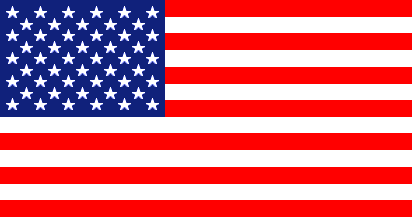
God Bless America
|
View
Cart & Check-Out
JANUARY
2026
877.267.3877
515.299.5388
24 / 7
WE answer
our
phones Personally!
|
|
